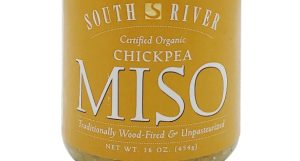
Last Updated on February 15, 2023 by Edible Alchemy Foods
Chickpea miso is a fermented soybean paste that’s made from chickpeas, barley and rice. It’s similar to other types of miso, which are made from soybeans or other grains, but has a unique flavor that makes it popular in its own right.
Chickpea miso has been around for hundreds of years and is traditionally used in Japanese cuisine. You can find it in many different types of dishes from soups to salads.
What Is Chickpea Miso?
Chickpea miso is made by fermenting chickpeas, barley and rice together with salt, koji (mold spores) and yeast. This process creates enzymes that break down the starches in the ingredients into simpler sugars that can be consumed by gut bacteria. The fermentation process also produces lactic acid, which gives the final product its characteristic tangy flavor.
You can find chickpea miso at most Asian grocery stores or online retailers like Amazon or Thrive Market. It comes in both paste form (similar to peanut butter) and dry powder form (similar to powdered peanut butter). If you’re using it as an ingredient in another dish, I recommend going with the paste since it will be easier to incorporate into your recipe.
What Is Chickpea Miso Good For?
Chickpea miso has been used in Japanese cuisine since ancient times. It was traditionally used as an alternative source of protein in place of fish or animal products like eggs and milk (which were often restricted during Buddhist fasting periods). Chickpea miso can be used in place of soy sauce in recipes such as ramen noodles, tofu scrambles and stir-fries. It also makes a great marinade for meat substitutes like chicken fillets before they are cooked on the BBQ!
Is chickpea miso good for you?
Miso is a traditional Japanese seasoning made from fermented soybeans and grains. Miso paste has a salty and savory taste, and it’s commonly used in soups, stews, and sauces.
Miso has many health benefits because of its high protein content. It also contains essential amino acids such as leucine and valine, which help repair muscle tissue after exercise. In addition to this, miso paste is full of vitamins B1, B2, B6, E and K, as well as iron and zinc.
Chickpea miso is made from chickpeas instead of soybeans and grains like most other types of miso paste. Chickpea miso is often used in vegan recipes because it has a milder flavor than traditional varieties. It can be used in salads or on sandwiches instead of mayonnaise or mustard.
Chickpea miso can be made at home by combining dried chickpeas with salt and water, then letting them sit for several days until they turn into a thick paste that can be used as a substitute for other types of miso paste in recipes.
What does chickpea miso taste like?
Chickpea miso is a staple in Japanese cuisine, but it can be tricky to find in the UK. The main ingredient is chickpeas (or garbanzo beans) so it’s naturally gluten-free and vegan-friendly. It’s also high in protein and fibre, so it’s perfect for vegans who are looking for plant-based sources of protein.
Chickpea miso paste has a salty taste and a mild nutty flavor that can be used in stir fries and soups to add depth of flavor to your dish. It can be mixed with other ingredients or used as an ingredient on its own, depending on what you’re making.
The paste comes in two varieties: white (shiro) and red (aka). Both have different uses but they’re interchangeable when cooking. I tend to use white chickpea miso paste more often as it has a more subtle flavor compared to red which adds more color and spice to dishes like soups or salads.
Difference between white and yellow miso
White miso is made by fermenting soybeans and salt in a process similar to making cheese. The result is a creamy white paste that’s sweet and milder than other types of miso. White miso is often used as a substitute for dairy products in vegetarian recipes because it has a similar consistency, but it’s also delicious on its own as an ingredient in soups, stews and sauces.
Yellow miso is made from fermented soybeans and koji (a type of mold). It’s darker than white miso because it has more nutrients from the koji enzymes that were added during the fermentation process. Yellow miso has more umami flavor than white miso and has a slightly more assertive taste than its counterpart because of its higher salt content.
Does chickpea miso have gluten?
Chickpea miso is a fermented ingredient made from chickpeas and soy beans. The fermentation process results in the creation of koji, which is used to create miso paste.
Miso paste is made by fermenting grain or legumes with salt, water and koji (a fungus). It’s then dried into cakes or blocks.
Chickpea miso does not contain gluten because it doesn’t contain wheat or barley. If you’re concerned about cross-contamination, choose chickpea miso that’s made without soybeans.
Does chickpea miso have soy?
Chickpea miso is a soy-free alternative to traditional soybean paste. It’s made from fermented chickpeas and barley, which are ground into a paste and packed into jars. The texture of chickpea miso may vary depending on where you buy it, but most brands have a slightly grainy texture similar to peanut butter or sunflower seed butter.
You can use chickpea miso as a substitute for soy sauce and tamari in your recipes. It has a savory taste similar to soy sauce, but without the strong salty flavor. Chickpea miso is also high in protein and fiber, making it an excellent addition to salads, soups and sauces.
Chickpea Miso Nutrition Facts
One tablespoon (14 grams) of chickpea miso contains:
90 calories
2 grams protein (7 percent DV)
6 grams carbohydrates (5 percent DV)
0 grams fat (0 percent DV)








![Is McCormick Au Jus Gluten-Free? [Answered]](https://ediblealchemyfoods.com/wp-content/themes/rehub-theme/images/default/noimage_336_220.png)


